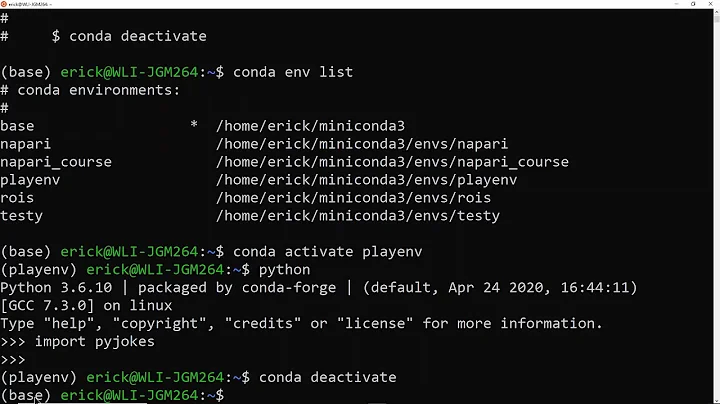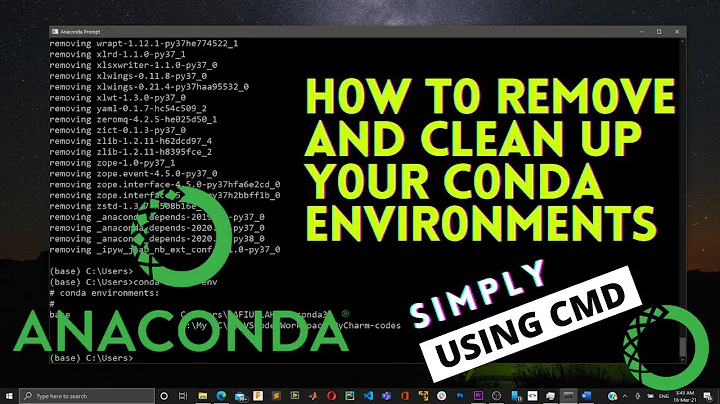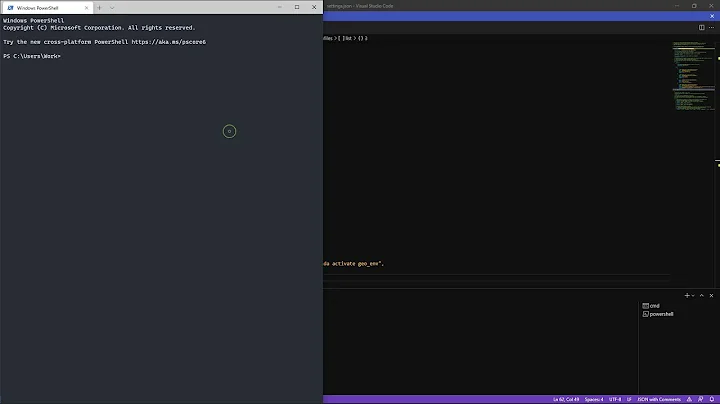How to remove (base) from terminal prompt after updating conda
Solution 1
Use the base env's activation hook
For each env, any scripts in the etc/conda/activate.d directory will be executed post-activation (likewise etc/conda/deactivate.d scripts for deactivation). If you add a script to remove the (base), similar to @ewindes suggestion, you'll get the behavior you desire.
I had to create this directory for base, which is just the root of your Anaconda/Miniconda folder. E.g.,
mkdir -p miniconda3/etc/conda/activate.d
Then made a simple file in there (e.g., remove_base_ps1.sh) with one line:
PS1="$(echo "$PS1" | sed 's/(base) //') "
If you are using zsh, use this instead.
PROMPT=$(echo $PROMPT | sed 's/(base) //')
Launching a new shell then does not show (base), and deactivating out of nested envs also takes care of the PS1 change.
Note: You must add quotes around $PS1 if you want to preserve ending spaces.
Solution 2
That's because conda's base environment is activated on startup.
To set the auto_activate_base parameter to false, type:
conda config --set auto_activate_base false
Edited 2021/09/09:
If you are facing the exact same situation as the OP, that you are using conda to manage environments, and wanted to make (base) environment looks no different to system environment in terminal, check @merv 's answer for the procedures. Note that the prompt string is stored in a certain special variable, depending on the shell you are using, so check the documentation of your shell if it does not work for you.
If you want to use the system environment and not using conda at all, my original answer was the solution for you.
Thanks to @merv and @Neinstein for pointing out in the comments.
Solution 3
By default, auto_activate_base is set to True when installing anaconda.
To check this, run:
$ conda config --show | grep auto_activate_base
auto_activate_base: True
To set it False
conda config --set auto_activate_base False
and vice-versa.
Note, if changeps1 is kept False, it will hide (env) completely, and in case you want to show (env) only when it's activated, you can set changeps1 to True:
conda config --set changeps1 True
Setting
changeps1toFalsewill hide(env)even if theenvis activated and will keep hiding(base)even afterauto_activate_baseis set toTrue.
Solution 4
You could add a command to your .bashrc to remove the "(base)" string from PS1:
PS1=$(echo $PS1 | sed 's/(base)//')
Solution 5
For me, what worked was:
conda config --set changeps1 false
Related videos on Youtube
Homero Esmeraldo
Computer Engineer and Graduate student in Computational Neuroscience.
Updated on April 07, 2022Comments
-
Homero Esmeraldo about 2 years
After updating miniconda3, whenever I open a terminal it shows "(base)" in front of my username and host.
In this answer post https://askubuntu.com/a/1113206/315699 it was suggested to use
conda config --set changeps1 FalseTo remove it.
But that would remove the indication for any conda environment. I would like to remove it only for the base one, so that I can maintain it always active and have access to its python and installed packages without having to always see this (base) taking up space.
-
David about 5 yearsYour answer adds a space at the beginning of
PS1and removes a space after$, so the text looks like:_rosgori@sa6:~$cd Documents/. This line improves that:PS1="$(echo $PS1 | sed 's/(base) //') ", unfortunately, when you activate another env, then deactivate, the(base)will be there. -
merv over 4 yearsThe issue in OP is that they don't want the PS1 change even when base is activated.
-
 ether_joe over 4 yearsthis is what I was looking for.
ether_joe over 4 yearsthis is what I was looking for. -
merv almost 4 yearsWhat does this add that is not already in this other early answer?
-
merv over 3 yearsThat removes it for everything - please reread the OP (only wants change for base). Even if this was what was desired,
changeps1would be more effective; this solution still results in running code to manage PS1 even though it only ever inserts empty strings. -
Homero Esmeraldo over 3 yearsYou should make sure you know what is the consequence of commenting these lines apart from removing "base" from the shell label.
-
Ed Griebel over 3 yearsThis is the one that worked for me in zsh with OhMyZsh on macOS Catalina (10.15) when the accepted answer didn't, probably because prompts are done slightly differently than bash
-
 Awaaaaarghhh over 3 yearsDoesn't work for me (conda 4.8.3; Python 3.8.3). I have still the same "(base)" in my shell.
Awaaaaarghhh over 3 yearsDoesn't work for me (conda 4.8.3; Python 3.8.3). I have still the same "(base)" in my shell. -
merv over 3 years@Awaaaaarghhh ask a new question with details on how it failed and I'll have a look. Include the output of
conda infoin the question. -
 Awaaaaarghhh over 3 years@merv probably one just need to reboot the PC after executing your commands. - Just restarting the shell didn't help.
Awaaaaarghhh over 3 years@merv probably one just need to reboot the PC after executing your commands. - Just restarting the shell didn't help. -
merv over 3 yearsI strongly recommend against this. Those double exclamation warnings are there to indicate that you shouldn't edit this region. Plus, this removes all the newer Conda v4.4+ shell functionality and leaves only the pre-v4.4 PATH management which the devs only include as an absolute baseline fallback (e.g., for unsupported shells only).
-
memeplex over 3 yearsThere is an extra space at the end. OTOH there is no need to add the double quotes in this kind of bash assignments.
-
 ceremcem over 3 years
ceremcem over 3 years[[ $PS1 =~ ^\(base\) ]] && conda config --set auto_activate_base falsepersistent between (re)installations. (Add it into~/.bashrc, after Conda's section) -
Zaki Aziz about 3 years@merv you can do that by running this:
conda config --set changeps1 false -
merv about 3 years@ZakiAziz that affects all environments. OP only wants base environment not to change PS1, other envs should still change it. Many people seem to end up on this question, when really they want to prevent base auto-activation or prevent editing PS1.
-
merv about 3 yearsBut how do you get this to only prevent it for base and no other environment? That is OP's question. This is instead answering this question.
-
 Neinstein almost 3 yearsThis does not make the
Neinstein almost 3 yearsThis does not make the(base)prefix hidden for the base environment, this makes the base environment not activate at all. The shell will use the system Python, not the Anaconda one! This is not what OP wants at all, and it will cause a lot of problem for inexperienced users. If you do aconda activate, the(base)conda prefix will appear, as you actually load it. The fact this answer has 98+ upvotes show how harmful it is - 98 people thought they solved this problem, while they didn't. -
Yokissa over 2 years@Neinstein You are right in saying that this is not the correct answer to the OP's question. I was not aware that conda was used to manage environments when I answered this question and it was my intention to go back to use the system environment when my search end up at this question, so I left my solution here. I will edit the answer accordingly.
-
 rbatty19 about 2 yearsit worked, but is also important to have run
rbatty19 about 2 yearsit worked, but is also important to have runconda config --set auto_activate_base false -
 Manishyadav about 2 yearsokk i'll keep this in mind!!
Manishyadav about 2 yearsokk i'll keep this in mind!! -
water stone about 2 yearsthere is nothing wrong commenting out or simply removing those lines, you can also choose not to let conda to add those lines to your .bashrc. as long as you set the PATH etc env variables to your preference, there is no need for these lines to exist








